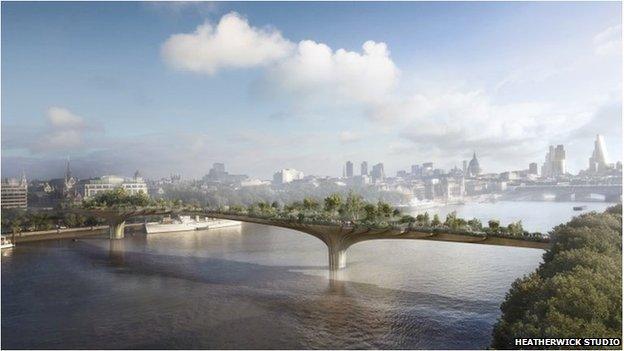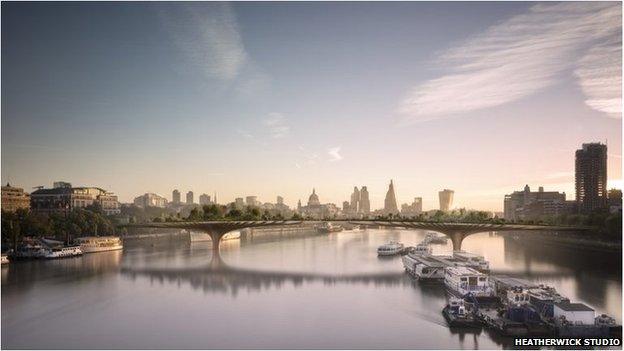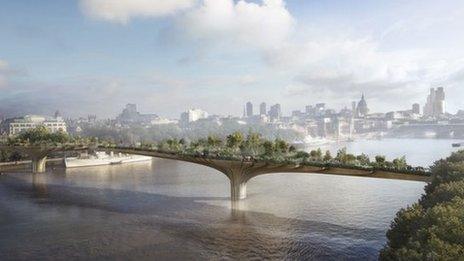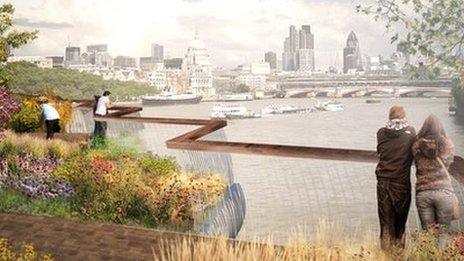Opposition to River Thames garden bridge plan grows
- Published
- comments
Some people living and working nearby are objecting to the bridge
A proposed "garden bridge" will span the Thames between Temple and the South Bank and is billed as a beautiful garden area with 270 trees.
It has the high profile backing of the Mayor of London, actress Joanna Lumley and architect Thomas Heatherwick, who designed the new bus for London and the London Olympic cauldron.
But local opposition is growing to the project and some residents are not happy.
Petitions have been started to stop the bridge, as has a campaign called Thames Open Central Space.
The argument of some of those who live locally is the bridge is in the wrong place and is not needed.
The detail within the planning application is also very interesting, as it reveals Temple Tube station would be shut for six months.


More than 30 trees will be cut down and green space on the South Bank would be lost to house the bridge landing at Bernie Spain Gardens.
Campaigners say they are losing green space to build green space and this makes no sense.
The planning application estimates there would be 7.1 million visitors a year to the bridge or about 30,000 a day.
It will be open from 06:00 until midnight 365 days a year, but cyclists will not be able to use the bridge.
Overcrowding
The campaigners argue the South Bank already has plenty of tourists and the bridge would cause overcrowding.
The City of London has also raised concerns about the protected views of St Paul's Cathedral, as the building could obscure the building from some sections of the South Bank.
There is also concern over the finances, as the cost to the public purse was meant to be low because most of the project was meant to be privately funded.
TfL agreed "enabling costs" of £4m, now the Mayor has announced TfL will pay £30m to the project and the Treasury will match that.
But there is a get-out clause: "It is proposed that around £38m each will be provided by TfL and the government in the pre-contract phase; if the project does not proceed beyond the stage, this funding will be at risk."
According to an executive summary for the Mayor in June 2014 the cost of the bridge was £159m, although recently in a report by the Guardian, external the total was announced as £175m.
In total over £100m will have to come from private donors and the bridge will cost £2.5m a year to run.
Caroline Pidgeon, from the Liberal Democrats on the London Assembly, says this follows a pattern from the Mayor where initially it is promised that not much public money will be used, but eventually TfL ends up footing the bill.

Campaigners say they are losing green space to build green space

The bridge will link Southbank to the north side of the river at Temple Tube station
The accusation is the same thing that happened before with hire bikes scheme and the cable car.
The business case has a benefit to cost ratio of 1.9:1, meaning you get £1.90 back for every £1 investment, which puts the bridge at the lower end of the benefits of transport projects.
Compare that to these other figures from TfL:
Crossrail 3.1:1
Victoria Line upgrade 5.2:1
Sub surface upgrade 8.1:1
Future Tube upgrades 3.3:1
TfL says the bridge will create new opportunities for walking, reduce journey times and support economic development on both sides of the river.
According to the planning application, the trees on the bridge will be restricted to 49 ft (15m) in height to protect the views.
Lambeth Council will consider the planning application in November.
- Published9 January 2014

- Published1 November 2013

- Published13 June 2013
